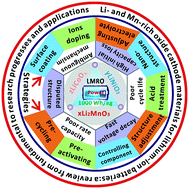当前位置:
X-MOL 学术
›
Mol. Syst. Des. Eng.
›
论文详情
Our official English website, www.x-mol.net, welcomes your
feedback! (Note: you will need to create a separate account there.)
Li- and Mn-rich layered oxide cathode materials for lithium-ion batteries: a review from fundamentals to research progress and applications
Molecular Systems Design & Engineering ( IF 3.2 ) Pub Date : 2018-07-18 00:00:00 , DOI: 10.1039/c8me00025e Hongge Pan 1, 2, 3, 4, 5 , Shiming Zhang 1, 2, 3, 4, 5 , Jian Chen 5, 6, 7, 8 , Mingxia Gao 1, 2, 3, 4, 5 , Yongfeng Liu 1, 2, 3, 4, 5 , Tiejun Zhu 1, 2, 3, 4, 5 , Yinzhu Jiang 1, 2, 3, 4, 5
Molecular Systems Design & Engineering ( IF 3.2 ) Pub Date : 2018-07-18 00:00:00 , DOI: 10.1039/c8me00025e Hongge Pan 1, 2, 3, 4, 5 , Shiming Zhang 1, 2, 3, 4, 5 , Jian Chen 5, 6, 7, 8 , Mingxia Gao 1, 2, 3, 4, 5 , Yongfeng Liu 1, 2, 3, 4, 5 , Tiejun Zhu 1, 2, 3, 4, 5 , Yinzhu Jiang 1, 2, 3, 4, 5
Affiliation

|
Li- and Mn-rich layered oxides (LMRO) have drawn much attention for application as cathode materials for lithium-ion batteries due to their high-energy density of over 1000 W h kg−1. However, several issues and challenges need to be overcome before realizing the commercialization of LMRO cathode materials, including their disputed crystal structure, ambiguous reaction mechanism, high initial irreversible capacity, poor cycle life, fast voltage fading, and poor rate capability. In this paper, we systematically review the development history, elaborate the fundamentals and demonstrate the latest research advances in LMRO cathode materials. Furthermore, the applications of LMRO cathode materials and their related key technical issues in full-cells, as well as the prospects for future research are also discussed.
中文翻译:

用于锂离子电池的富含锂和锰的层状氧化物正极材料:从基础到研究进展和应用的综述
富锂和富锰的层状氧化物(LMRO)由于其超过1000 W h kg -1的高能量密度而在锂离子电池正极材料中的应用备受关注。但是,在实现LMRO阴极材料的商业化之前,需要克服几个问题和挑战,包括它们有争议的晶体结构,模棱两可的反应机理,高的初始不可逆容量,较差的循环寿命,快速的电压衰减和较差的倍率能力。在本文中,我们系统地回顾了其发展历史,阐述了基础知识,并展示了LMRO阴极材料的最新研究进展。此外,还讨论了LMRO阴极材料在全电池中的应用及其相关的关键技术问题,以及未来研究的前景。
更新日期:2018-07-18
中文翻译:

用于锂离子电池的富含锂和锰的层状氧化物正极材料:从基础到研究进展和应用的综述
富锂和富锰的层状氧化物(LMRO)由于其超过1000 W h kg -1的高能量密度而在锂离子电池正极材料中的应用备受关注。但是,在实现LMRO阴极材料的商业化之前,需要克服几个问题和挑战,包括它们有争议的晶体结构,模棱两可的反应机理,高的初始不可逆容量,较差的循环寿命,快速的电压衰减和较差的倍率能力。在本文中,我们系统地回顾了其发展历史,阐述了基础知识,并展示了LMRO阴极材料的最新研究进展。此外,还讨论了LMRO阴极材料在全电池中的应用及其相关的关键技术问题,以及未来研究的前景。











































 京公网安备 11010802027423号
京公网安备 11010802027423号